You can create effective neem oil blends by mixing 1-2 tablespoons of cold-pressed neem oil with one gallon of water and 1-2 teaspoons of mild dish soap for general pest control. For sensitive plants, use just one teaspoon per quart of water. Enhance effectiveness by adding crushed garlic for extra repellent action, or apply as a soil drench around plant bases. Apply during early morning or evening to prevent leaf burn. These simple combinations will transform your pest management approach.
Basic Neem Oil and Dish Soap Blend for General Pest Control
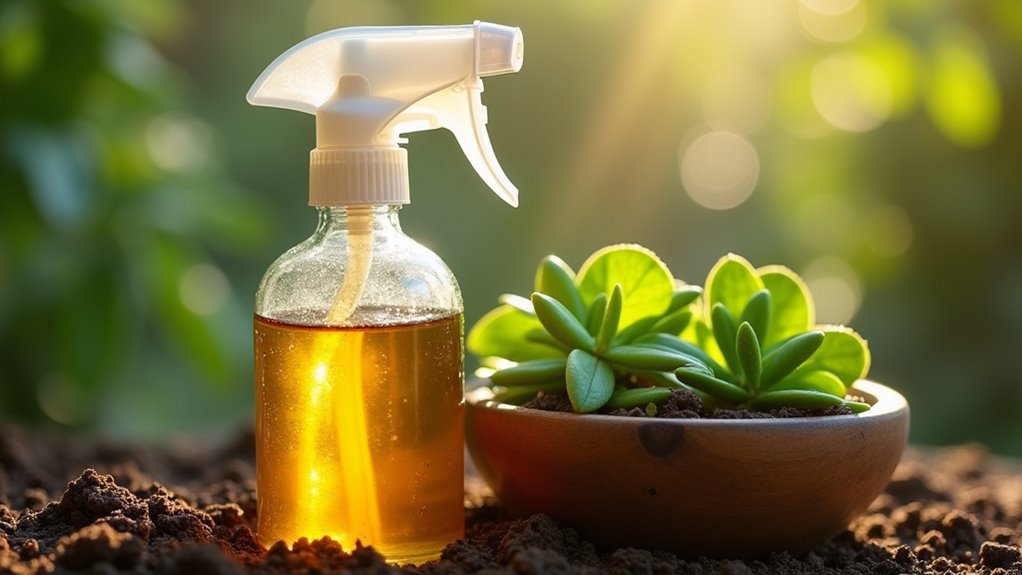
When dealing with common houseplant pests, you’ll find that a simple neem oil and dish soap blend offers one of the most effective and versatile solutions for your indoor garden.
Mix 1-2 tablespoons of cold-pressed neem oil with one gallon of water and 1-2 teaspoons of mild liquid dish soap to create your neem oil solution. This blend targets soft-bodied pests like aphids, mealybugs, and spider mites while fighting fungal diseases such as powdery mildew.
This powerful neem oil blend eliminates aphids, mealybugs, spider mites, and powdery mildew with just three simple ingredients.
Apply neem oil thoroughly on all plant surfaces, including leaf undersides where pests hide. Spray during early morning or late evening to prevent leaf burn.
To control pests effectively, reapply every 7-14 days for prevention or every 3-4 days during active infestations.
Concentrated Neem Oil Spray for Heavy Infestations
When you’re facing a severe pest outbreak that’s overwhelming your houseplants, you’ll need a more aggressive approach with double-strength neem oil concentrations.
Mix 2 tablespoons of cold-pressed neem oil with 1 gallon of water and 2 teaspoons of mild liquid soap to create this potent solution.
You can apply this concentrated spray every 7 to 10 days as an emergency treatment until you see the pest population dramatically decline.
Double Strength Mixing Ratios
Four tablespoons of neem oil per gallon of water creates the double-strength solution you’ll need to combat severe pest infestations on your houseplants.
This neem oil concentrate delivers maximum potency when standard treatments aren’t enough. Add two teaspoons of mild liquid soap to help the mixture stick to plant surfaces and improve coverage.
Focus your spraying on leaf undersides and stems where pests typically hide. Apply this concentrated blend every five to seven days, monitoring your plants closely for stress signs.
The increased strength requires careful observation to guarantee your houseplants tolerate the treatment well.
Before using the full-strength mixture, test it on a small plant section first. This precautionary step helps you control potential damage while maximizing pest elimination effectiveness.
Emergency Application Frequency
Heavy pest infestations demand immediate action with concentrated neem oil applications every 3 to 4 days.
When you’re dealing with a current infestation, this aggressive schedule helps break pest reproduction cycles and reduces populations quickly. Your neem oil spray won’t show results immediately—expect to wait at least 2 days before noticing significant changes in pest activity.
Keep applying neem oil until you see pest numbers declining substantially.
Monitor your plants closely after each treatment to track progress and adjust timing if needed. This frequent application schedule works because it targets multiple generations of pests before they can establish themselves.
Gentle Neem Oil Mix for Sensitive Plant Varieties
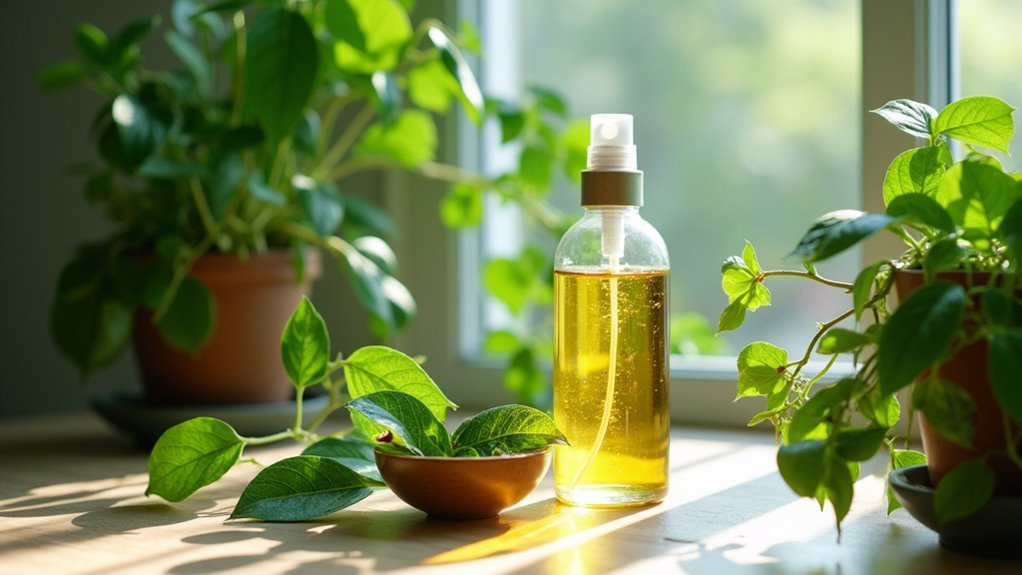
Since sensitive plant varieties like African violets, ferns, and young seedlings can easily suffer damage from standard pest treatments, you’ll need a more diluted gentle neem oil mix to protect them.
Mix 1 teaspoon of neem oil with 1 quart of water and 0.5 teaspoon of mild dish soap. Before treating your entire plant, conduct a patch test on a small area to check for adverse reactions.
Always test your diluted neem oil solution on a small plant section before full application to avoid potential damage.
Apply the neem oil blend during early morning or late evening to prevent sun damage. Focus on thoroughly misting leaf undersides and crevices where pests hide.
For prevention, reapply every 7-14 days, or every few days if you’ve detected pest issues. Quality neem oil products guarantee effective protection for sensitive plant varieties.
Neem Oil and Garlic Combination for Enhanced Repellent Action
You’ll find that extracting garlic’s potent compounds properly makes all the difference in creating an effective neem oil blend.
Fresh garlic cloves release more allicin when crushed or blended with water, giving you stronger pest-repelling power than using garlic powder or pre-made extracts.
Getting the ratios right between your garlic extract and neem oil guarantees you won’t overwhelm sensitive plants while still maintaining the enhanced repellent action you’re after.
Garlic Extraction Methods
Garlic’s pungent aroma makes it a powerful ally when combined with neem oil, creating a dual-action pest control solution that’s particularly effective against stubborn houseplant invaders. The garlic extraction process is straightforward and requires minimal preparation time.
Start by crushing 2-3 fresh garlic cloves and steeping them in 1 cup of water overnight. This allows the garlic’s natural compounds to infuse into the water, creating a potent concentrate.
Strain the mixture the next morning to remove solid particles.
Combine 1 tablespoon of your garlic extract with 1-2 tablespoons of neem oil and 1 gallon of water. This blend helps prevent pests like aphids and spider mites while supporting overall plant health by potentially reducing fungal diseases.
Application Ratios Guidelines
Three key measurements determine the effectiveness of your neem oil and garlic combination, and getting these ratios right can mean the difference between pest control success and plant damage.
Mix 1 to 2 tablespoons of cold-pressed neem oil with 1 cup of minced garlic that’s been steeped in 1 quart of water. These application ratios create a potent neem oil spray without overwhelming your plants.
Apply this blend every 7 to 14 days as a preventative measure against aphids and whiteflies. If you’re dealing with active infestations, increase frequency accordingly.
Always shake well before spraying and coat both leaf surfaces thoroughly. These careful ratios guarantee you’ll eliminate pests while protecting beneficial insects that support your houseplant ecosystem.
Quick Application Neem Oil Blend for Small Plants
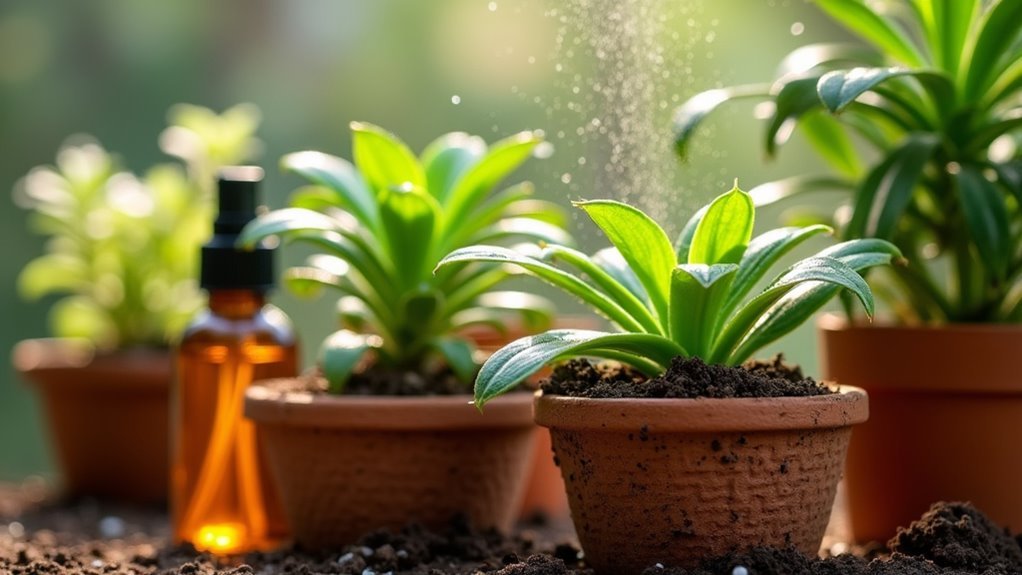
When dealing with smaller houseplants, you’ll find that a simple neem oil blend offers an efficient solution for pest management without overwhelming delicate foliage.
Mix 1 teaspoon of cold-pressed neem oil with 1 quart of water and 0.5 teaspoon of mild liquid soap for small plants. This balanced ratio guarantees effective treatment without damaging sensitive leaves.
The steps to apply are straightforward: test the solution on one leaf first, then spray thoroughly, focusing on leaf undersides and crevices where pests hide.
Using neem oil spray every 7-14 days prevents infestations, while twice-weekly applications combat active pest problems. This neem oil to control method works best when applied immediately after mixing, as the solution degrades quickly.
Preventative Neem Oil Solution for Regular Maintenance
You’ll want to establish a consistent preventative routine to keep pests away from your houseplants before they become a problem.
A basic prevention recipe requires just a few simple ingredients mixed in the right proportions for effective coverage.
Following proper application schedule guidelines guarantees you’re protecting your plants without overdoing the treatments.
Basic Prevention Recipe
Although pest prevention requires consistency, creating an effective neem oil solution is surprisingly straightforward.
Mix 1 to 2 tablespoons of cold-pressed neem oil with 1 gallon of water, then add 2 teaspoons of mild liquid soap for proper emulsification. This preventative mixture protects your plant health by stopping pest infestations before they start.
Apply this solution every 7 to 14 days, ensuring you spray all plant surfaces thoroughly. Pay special attention to leaf undersides where pests typically hide.
Time your applications for early morning or late evening to prevent leaf burn from direct sunlight exposure.
Always prepare fresh batches since mixed solutions lose their effectiveness after about 8 hours. This simple recipe keeps your houseplants healthy year-round.
Application Schedule Guidelines
Since consistent application forms the foundation of effective pest prevention, you’ll want to establish a regular maintenance schedule that keeps your houseplants protected year-round.
Apply your neem oil solution every 7 to 14 days as a preventative measure to maintain ideal plant health and deter unwanted insects.
When you notice signs of pest activity, immediately shift to a more aggressive application schedule.
Spray twice weekly during acute infestations to eliminate existing pests quickly. Always cover all plant surfaces thoroughly, including leaf undersides where pests often hide.
Mix fresh solutions for each treatment since neem oil loses effectiveness after 8 hours.
Monitor your plants regularly and adjust timing based on current pest activity levels, increasing frequency whenever threats emerge.
Neem Oil Soil Drench Recipe for Root-Level Protection
When soil-dwelling pests threaten your houseplants from below, a neem oil soil drench delivers targeted protection directly to the root zone. This organic gardening solution effectively combats bug infestations hiding in soil.
Mix 1-2 tablespoons of cold-pressed neem oil with 1 gallon of warm water, then add 1-2 teaspoons of mild liquid soap to emulsify the mixture.
Before applying, verify your soil’s already moist for better absorption.
Pour the soil drench directly around your plant’s base, letting roots absorb the solution. Remove excess liquid from saucers after a few minutes.
For prevention, reapply every three weeks. If you’ve detected pests, increase frequency to weekly applications.
Monitor your plants closely—neem oil works systemically and may take several days to show noticeable effects.
Cold-Pressed Neem Oil Blend for Maximum Potency
While soil drenches protect plants from below-ground threats, foliar applications target visible pests on leaves and stems more directly.
Cold-pressed neem oil offers maximum potency for pest control, derived from the seeds of the neem tree with 1-3% azadirachtin content. This concentrated formulation provides superior effectiveness against soft-bodied pests and fungal diseases.
Cold-pressed neem oil delivers maximum pest control potency with 1-3% azadirachtin concentration for superior plant protection.
To Use Neem Oil effectively, create a fresh blend combining water and oil with mild liquid soap:
- Mix 1-2 teaspoons cold-pressed neem oil per quart of water
- Add 2-3 drops of mild liquid soap as emulsifier
- Shake thoroughly before each application
- Apply immediately after mixing for best results
Remember that this blend degrades quickly, losing effectiveness after 8 hours. Apply every 7-14 days for consistent pest prevention.
Lightweight Neem Oil Mist for Delicate Foliage
Although delicate houseplants like ferns, African violets, and baby plants require gentle pest control methods, they still benefit from neem oil’s protective properties.
You’ll create a lightweight neem oil mist by combining 1 teaspoon of cold-pressed neem oil with 1 quart of water and 0.5 teaspoon of gentle dish soap. Use a fine spray bottle to guarantee even distribution across delicate foliage without overwhelming sensitive leaves.
Apply the mist during early morning or late evening to prevent leaf burn and improve absorption. Regular applications every 7-14 days effectively prevent pest infestations while maintaining plant health.
Always conduct a patch test on a single leaf first to check for adverse reactions before treating your entire plant.
Multi-Purpose Neem Oil Treatment for Pests and Fungal Issues
Because many houseplants face multiple threats simultaneously, you’ll find that a multi-purpose neem oil treatment addresses both pest infestations and fungal issues with one effective solution.
The active compound azadirachtin disrupts pest growth while preventing fungal spore germination, making it perfect for tackling aphids, spider mites, and powdery mildew together.
Azadirachtin’s dual-action formula simultaneously eliminates common pests like aphids and spider mites while blocking fungal diseases at the source.
To create your dual-action blend:
- Mix 1-2 tablespoons cold-pressed neem oil with one gallon water
- Add several drops of mild liquid soap for proper emulsification
- Apply as foliar spray every 7-14 days
- Focus on leaf undersides where pests and spores hide
Regular applications not only manage existing problems but also prevent future outbreaks, promoting superior plant health through consistent protection.
Frequently Asked Questions
How to Mix Neem Oil for Indoor Plants?
You’ll mix 1-2 tablespoons of cold-pressed neem oil with 1 gallon of warm water and 1-2 teaspoons of mild liquid soap. Test on one leaf first, then spray all plant surfaces including undersides.
What Plants Not to Use Neem Oil on for Indoor Plants?
Don’t use neem oil on sensitive ferns, delicate succulents, caladiums, orchids, flowering petunias, geraniums, or citrus plants like lemons and limes. You’ll risk leaf burn, phytotoxic reactions, or pollination interference indoors.
What Is the Ratio of Neem Oil to Water for Plants?
You’ll want to mix 1-2 tablespoons of neem oil per gallon of water. For smaller batches, use 1-2 teaspoons per quart, and don’t forget to add mild soap for better coverage.
How Do You Make Pest Spray for Indoor Plants?
You’ll mix 1-2 tablespoons cold-pressed neem oil with 1 gallon water and 1-2 teaspoons mild soap. Shake well, spray all plant surfaces including leaf undersides, and reapply every 7-14 days.
In Summary
You’ve now got nine powerful neem oil blends to tackle any houseplant pest problem. Start with the gentler formulas for sensitive plants, then move to concentrated versions for stubborn infestations. Don’t forget to test each blend on a small area first, and apply during cooler parts of the day. With these recipes in your arsenal, you’ll keep your indoor garden healthy and pest-free year-round.

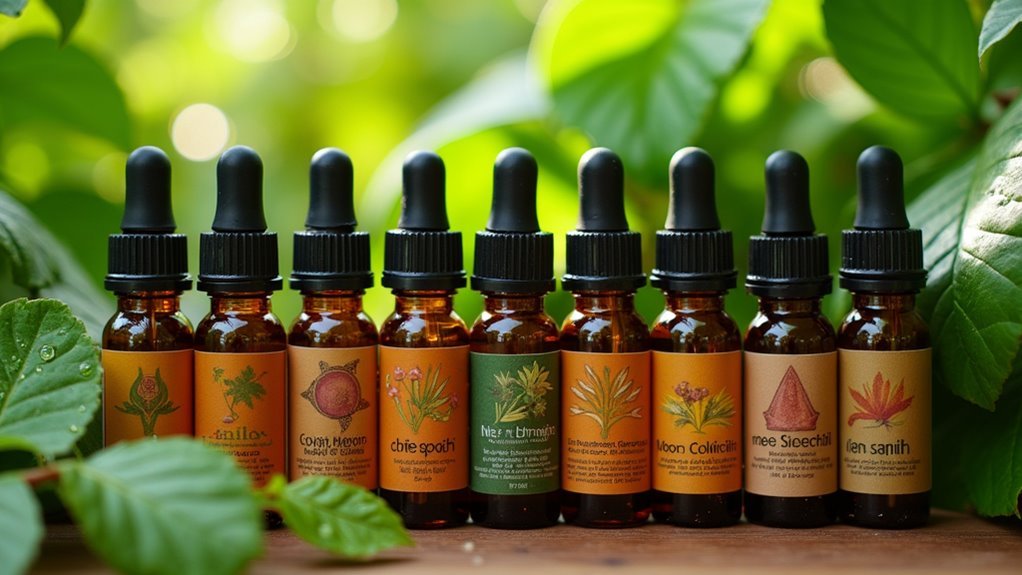
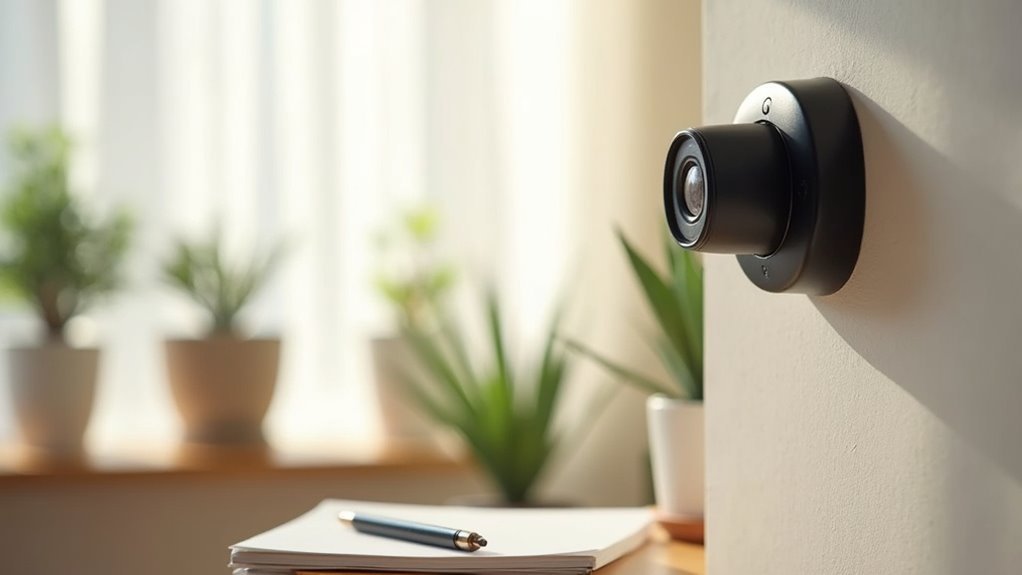

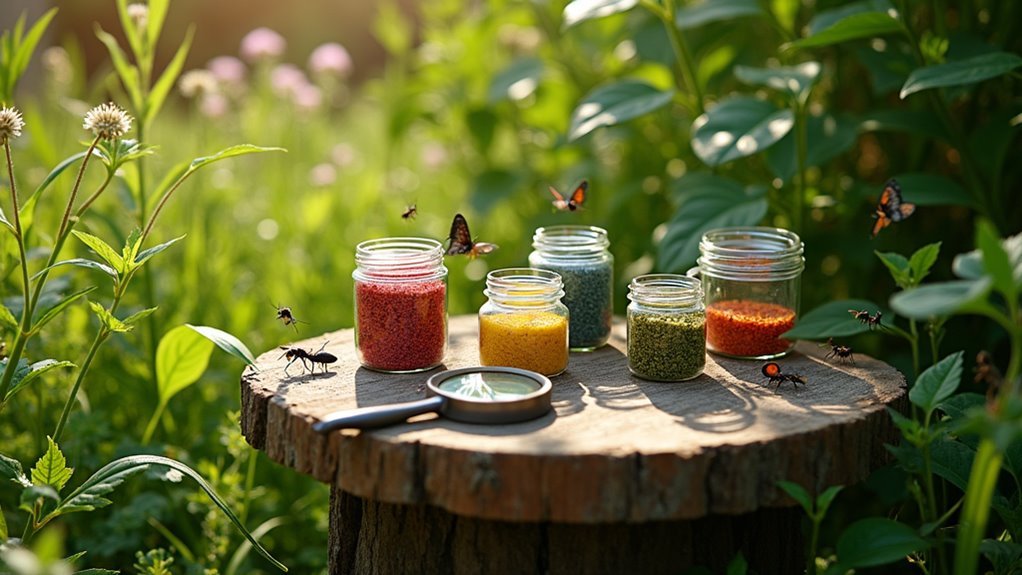
Leave a Reply